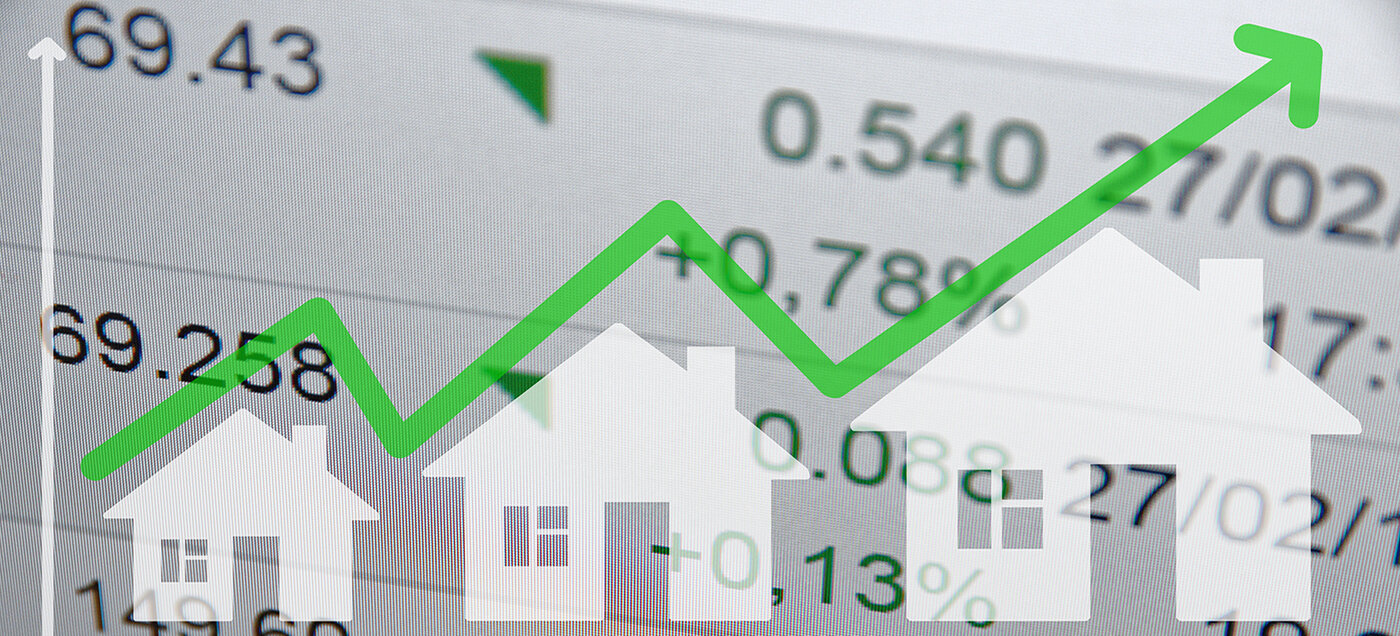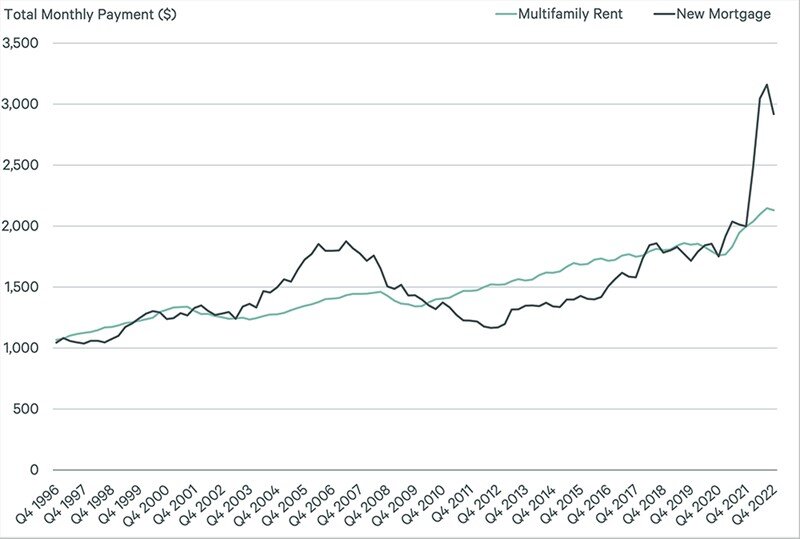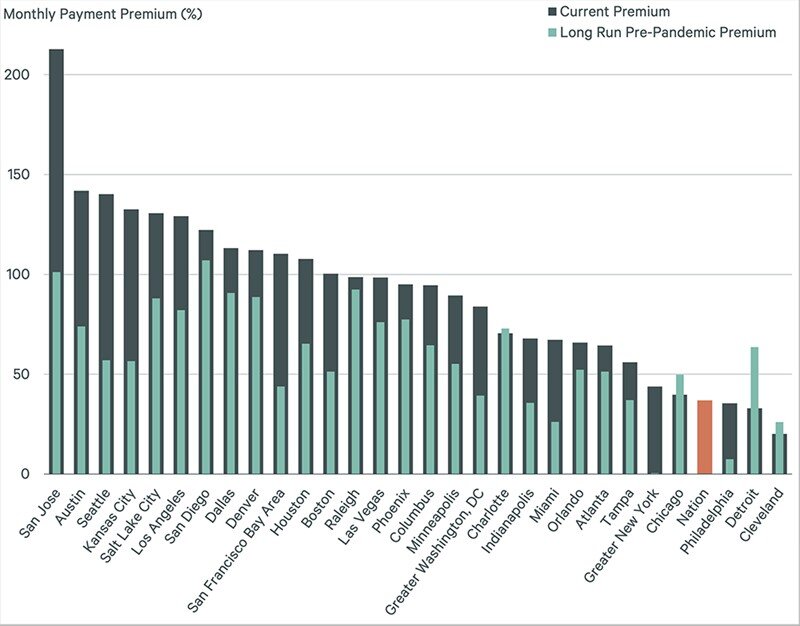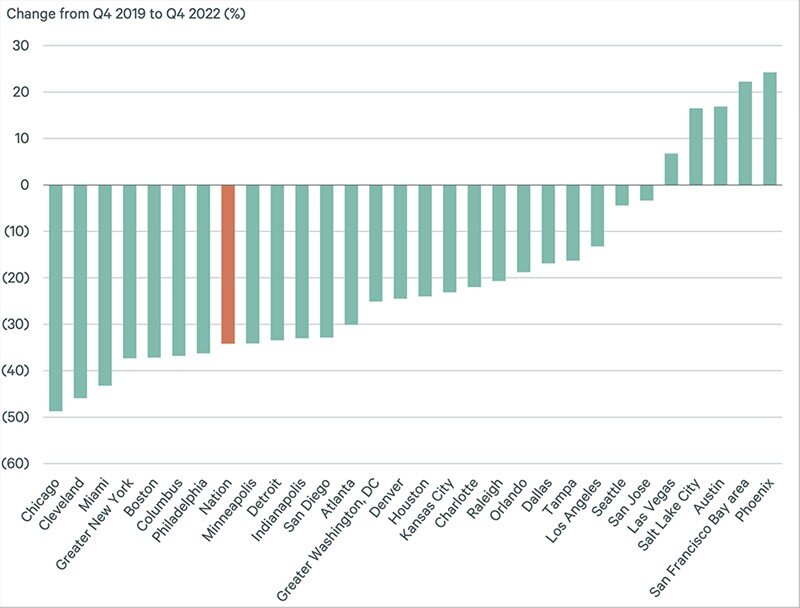Residential Real Estate News

Mortgage Payments Now Eclipse Apartment Rents in the U.S.
Residential News » Atlanta Edition | By Michael Gerrity | April 10, 2023 8:39 AM ET
According to new research by CBRE, U.S. homebuyers today face average monthly mortgage payments that are 37% higher than the average monthly apartment rent.
Historically, monthly mortgage payments for newly purchased homes have been roughly on par with monthly apartment rent payments. However, the emergence of a cost-of-ownership premium results from relatively high home prices and rapidly rising mortgage rates. The average monthly mortgage payment for a newly purchased home, including taxes, has increased 70% since the end of 2019. Half of that increase came from higher mortgage rates, with the balance due to higher home prices.
Home prices have fallen by 9.7% since Q2 2022 but not enough to significantly offset the impact of higher mortgage rates. For monthly mortgage payments on newly purchased homes to come back into line with CBRE's forecast rental rates at the end of 2023, home prices would have to decrease an additional 24% this year assuming no further rise in interest rates. By comparison, following the Global Financial Crisis, home prices declined by 19% from 2007 to 2012. This barrier to entry for home ownership likely will buoy multifamily demand as the housing market stabilizes over the near term.
The payment premium for homebuyers today varies by market and over time. Some markets such as New York and San Francisco have seen premiums increase due to higher home prices and relatively slower multifamily rent growth since the onset of the pandemic. Other markets like Miami and Kansas City have seen significant increases in both rent and home prices due to in-migration from higher-cost markets.
Conversely, markets such as San Diego and Phoenix are still seeing high premiums but are relatively in line with their long-run historical trend. These historical premiums are often the result of a large swing in home values during the housing boom of the early 2000s. For example, Phoenix has a current cost-of-ownership that is double its average rent, but in 2006 it was nearly triple the amount.
The relatively low number of homes for sale is another obstacle for would-be homebuyers. Since the beginning of the pandemic, active listings of for-sale homes have remained below trend. Nationally, active listings are 34% less than in Q4 2019.
With average mortgage rates at 6.42% as of March 2023, many Americans are now unable or unwilling to buy homes. A little more than half of all active U.S. mortgages were originated since the start of the pandemic, according to Black Knight Inc. With most of these loans being used to refinance existing mortgages, this has led to nearly 97% of all active U.S. mortgages having interest rates below current levels.
Despite a spate of new multifamily construction deliveries over the next 24 months, CBRE expects any negative impact on market fundamentals will be temporary. The overall U.S. housing shortage and higher mortgage rates are keeping demand for rental property strong. While some additional home price correction can be expected, ultimately it will be lower mortgage rates that will have the biggest impact on monthly mortgage payments as inflation comes down and the Fed begins to lower interest rates.
Sign Up Free | The WPJ Weekly Newsletter
Relevant real estate news.
Actionable market intelligence.
Right to your inbox every week.
Real Estate Listings Showcase
Related News Stories
Residential Real Estate Headlines
- U.S. New-Home Sales Surge in August as Mortgage Rates Ease
- Despite Increased Foreign Buyer Activity, Miami Residential Sales Dip 11 Percent in August
- California Home Sales Enjoy Modest Uptick as Mortgage Rates Ease
- U.S. Home-Flipping Profits Sink to Lowest Level Since 2008 Financial Crisis as Costs Climb
- Why the World's Rich Are Flocking to Europe in 2025
- Federal Reserve Delivers First Rate Cut of 2025 as Mortgage Relief Proves Limited
- Homebuilder Sentiment Holds Steady in U.S. as Rate-Cut Bets Lift Outlook
- U.S. Mortgage Rates Experience Sharpest Weekly Drop in Over a Year
- U.S. Foreclosures Rise for Sixth Straight Month as Affordability Pressures Mount
- Black U.S. Homeownership Rate Falls to Two-Year Low as Job Losses Mount
- Las Vegas Home Prices Flatten as Listings Surge, Sales Slow
- Cooling Miami Housing Market Sees 16 Percent Annual Sales Drop in July
- U.S. Mortgage Delinquencies Uptick in June Amid Regional Pressures
- California, Florida Top U.S. Housing Markets Most at Risk of Downturn
- 30-Year Mortgage Drops to 6.56 Percent in Late August, Lowest Since October 2024
- Investors Maintain Elevated Role in U.S. Housing Market Despite Slight Pullback
- Pending Home Sales Show Mixed Signals as U.S. Buyers Remain Cautious
- Canadian Home Sales Extend Recovery in July
- U.S. Home Sales Rise in July as Buyers Gain More Bargaining Power
- Zombie Foreclosures Edge Up Across U.S.
- 2.6 Million Homes at Wildfire Risk Across 14 Western States in 2025
- One in Five Americans Willing to Trade Personal Safety for Home Affordability
- U.S. Home Price Growth Slows as Affordability Pressures Mount in 2025
- U.S. Mortgage Rates Dip to Four Month Low in Early August
- U.S. Mortgage Applications Rise in Late July, Breaking Four-Week Slump
- Hong Kong's Housing Market Stuck in Stalemate as Bulls and Bears Face Off
- U.S. Condo Market Struggles in 2025
- U.S. Pending Home Sales Remain Sluggish in June
- Los Angeles Area Wildfires Destroyed Nearly $52 Billion in Homes Last January
- Greater Palm Beach Area Residential Sales Slip in June Amid Growing Inventory
- Economic Resilience Lifts U.S. Housing Outlook Going Forward
- New Home Sales Stagnate as Affordability Struggles Continue in America
- U.S. Housing Market Slips in June as Prices Hit New Highs
- Florida, California Continue to Reign Supreme as America's Ultraluxury Housing Markets
- Caribbean Housing Market Evolves into Global Second-Home Hotspot
- U.S. Home Sales See Highest June Cancellation Rate on Record
- Orlando Housing Market Cools in June as Listings Slide, Sales Slow
- Private Credit Surges in 2025 as Real Estate Developers Bypass Banks
- U.S. Condo Market Suffers Sharpest Price Drops in Over a Decade as Buyers Retreat
- Rising Taxes, Insurance Costs Undermine the Stability of U.S. Homeownership










